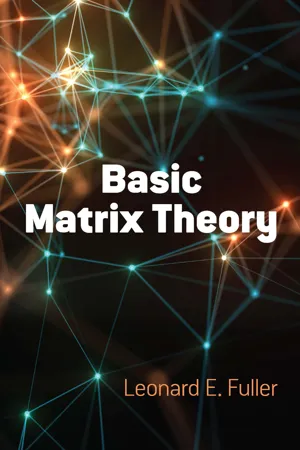
- 256 pages
- English
- ePUB (mobile friendly)
- Available on iOS & Android
eBook - ePub
Basic Matrix Theory
About this book
Written as a guide to using matrices as a mathematical tool, this text is geared toward physical and social scientists, engineers, economists, and others who require a model for procedure rather than an exposition of theory. Knowledge of elementary algebra is the only mathematical prerequisite. Detailed numerical examples illustrate the treatment's focus on computational methods.
The first four chapters outline the basic concepts of matrix theory. Topics include the development of the concept of elementary operations and a systematic procedure for simplifying matrices as well as a method for evaluating the determinant of a given square matrix. Subsequent chapters explore important numerical procedures, including the process for approximating characteristic roots and vectors plus direct and iterative methods for inverting matrices and solving systems of equations. Solutions to the problems are included.
The first four chapters outline the basic concepts of matrix theory. Topics include the development of the concept of elementary operations and a systematic procedure for simplifying matrices as well as a method for evaluating the determinant of a given square matrix. Subsequent chapters explore important numerical procedures, including the process for approximating characteristic roots and vectors plus direct and iterative methods for inverting matrices and solving systems of equations. Solutions to the problems are included.
Frequently asked questions
Yes, you can cancel anytime from the Subscription tab in your account settings on the Perlego website. Your subscription will stay active until the end of your current billing period. Learn how to cancel your subscription.
At the moment all of our mobile-responsive ePub books are available to download via the app. Most of our PDFs are also available to download and we're working on making the final remaining ones downloadable now. Learn more here.
Perlego offers two plans: Essential and Complete
- Essential is ideal for learners and professionals who enjoy exploring a wide range of subjects. Access the Essential Library with 800,000+ trusted titles and best-sellers across business, personal growth, and the humanities. Includes unlimited reading time and Standard Read Aloud voice.
- Complete: Perfect for advanced learners and researchers needing full, unrestricted access. Unlock 1.4M+ books across hundreds of subjects, including academic and specialized titles. The Complete Plan also includes advanced features like Premium Read Aloud and Research Assistant.
We are an online textbook subscription service, where you can get access to an entire online library for less than the price of a single book per month. With over 1 million books across 1000+ topics, we’ve got you covered! Learn more here.
Look out for the read-aloud symbol on your next book to see if you can listen to it. The read-aloud tool reads text aloud for you, highlighting the text as it is being read. You can pause it, speed it up and slow it down. Learn more here.
Yes! You can use the Perlego app on both iOS or Android devices to read anytime, anywhere — even offline. Perfect for commutes or when you’re on the go.
Please note we cannot support devices running on iOS 13 and Android 7 or earlier. Learn more about using the app.
Please note we cannot support devices running on iOS 13 and Android 7 or earlier. Learn more about using the app.
Yes, you can access Basic Matrix Theory by Leonard E. Fuller in PDF and/or ePUB format, as well as other popular books in Mathematics & Algebra. We have over one million books available in our catalogue for you to explore.
Information
Table of contents
- Cover
- Title Page
- Copyright Page
- Preface
- Contents
- 1. Basic Properties of Matrices
- 2. Elementary Matrix Operations
- 3. Vector Spaces and Linear Transformations
- 4. Determinants
- 5. Characteristic Roots and Vectors
- 6. Inversion of Matrices
- 7. Inversion of Matrices by Iteration
- 8. Homogeneous Forms
- Bibliography
- Answers to Problems
- Index